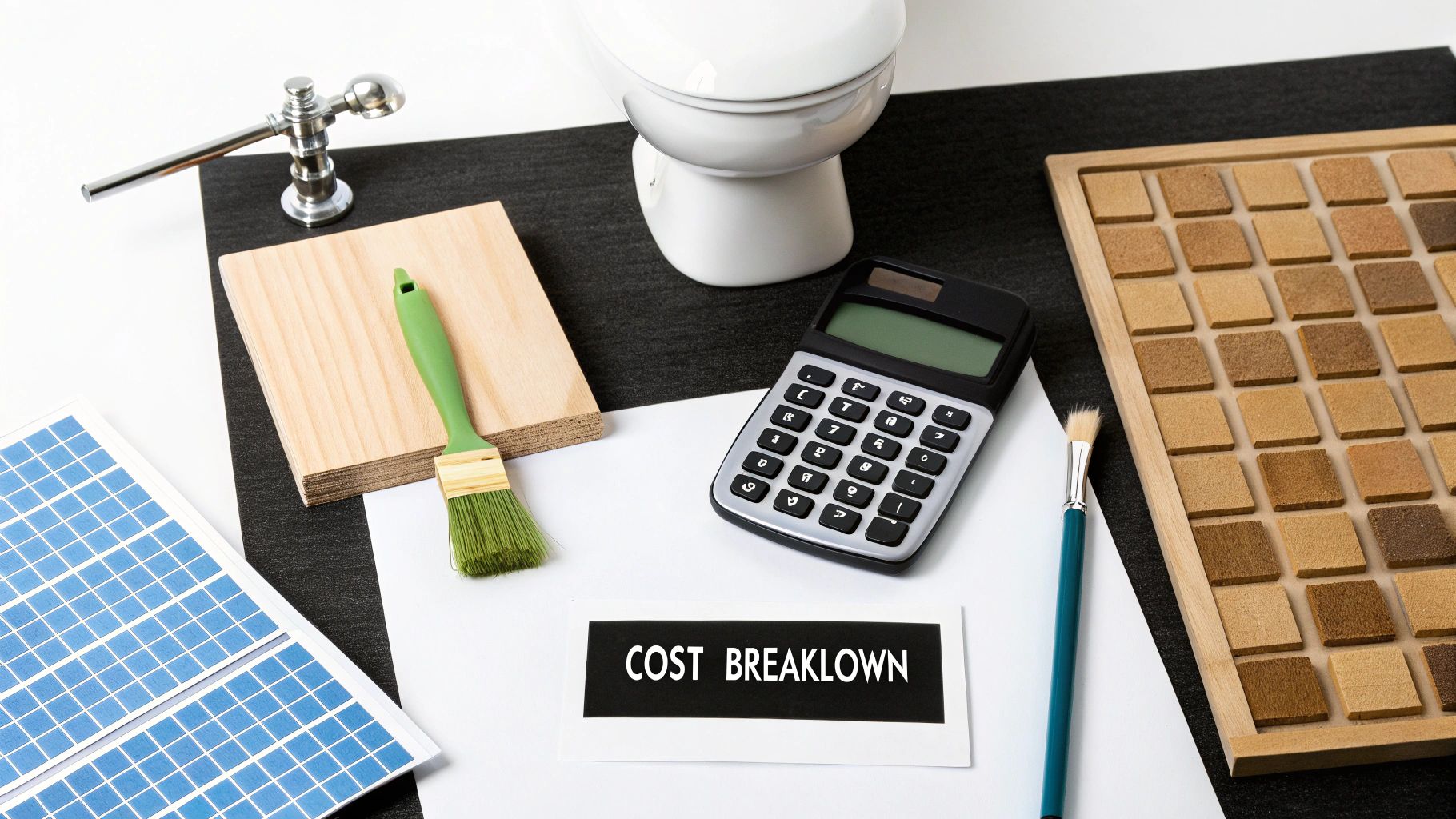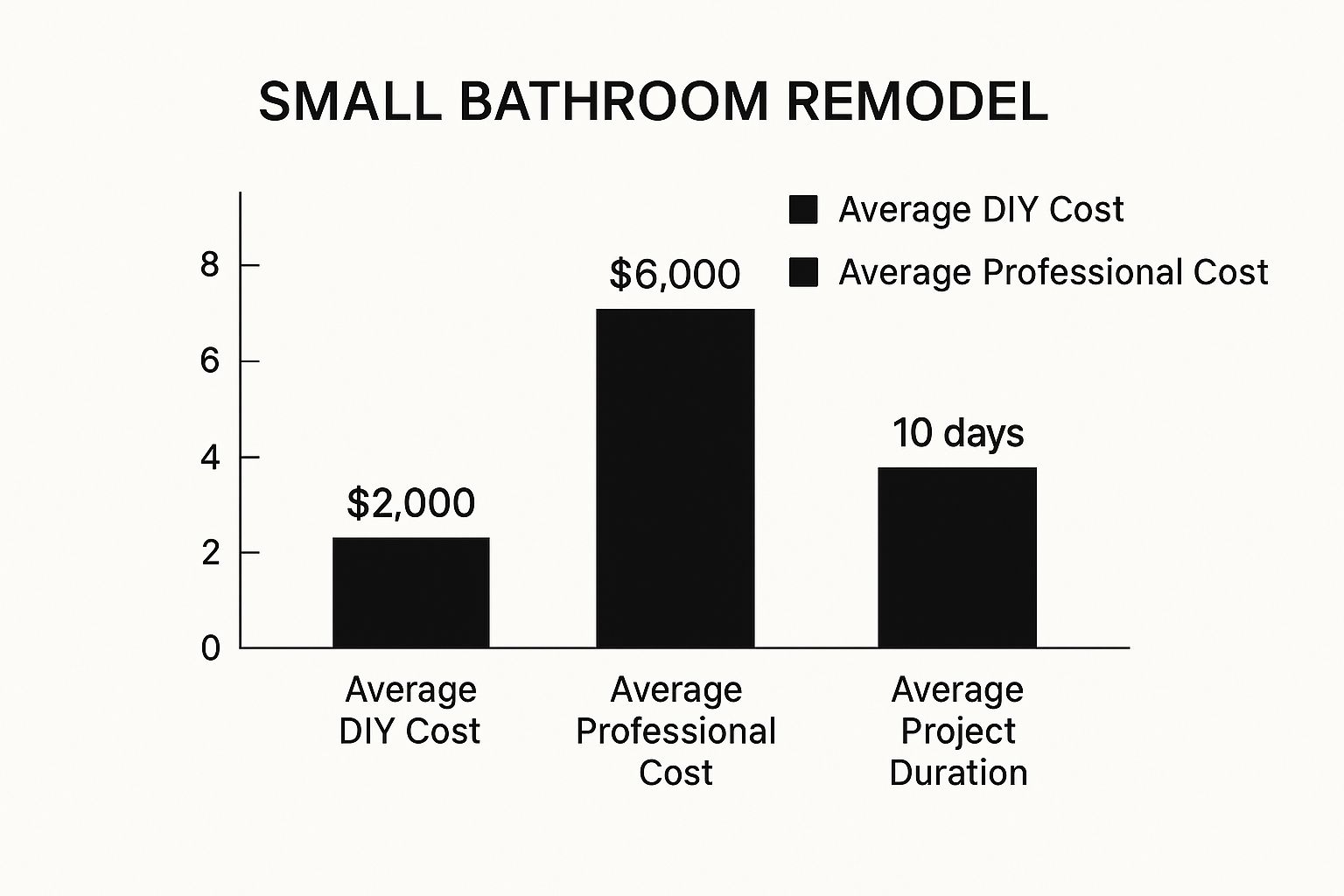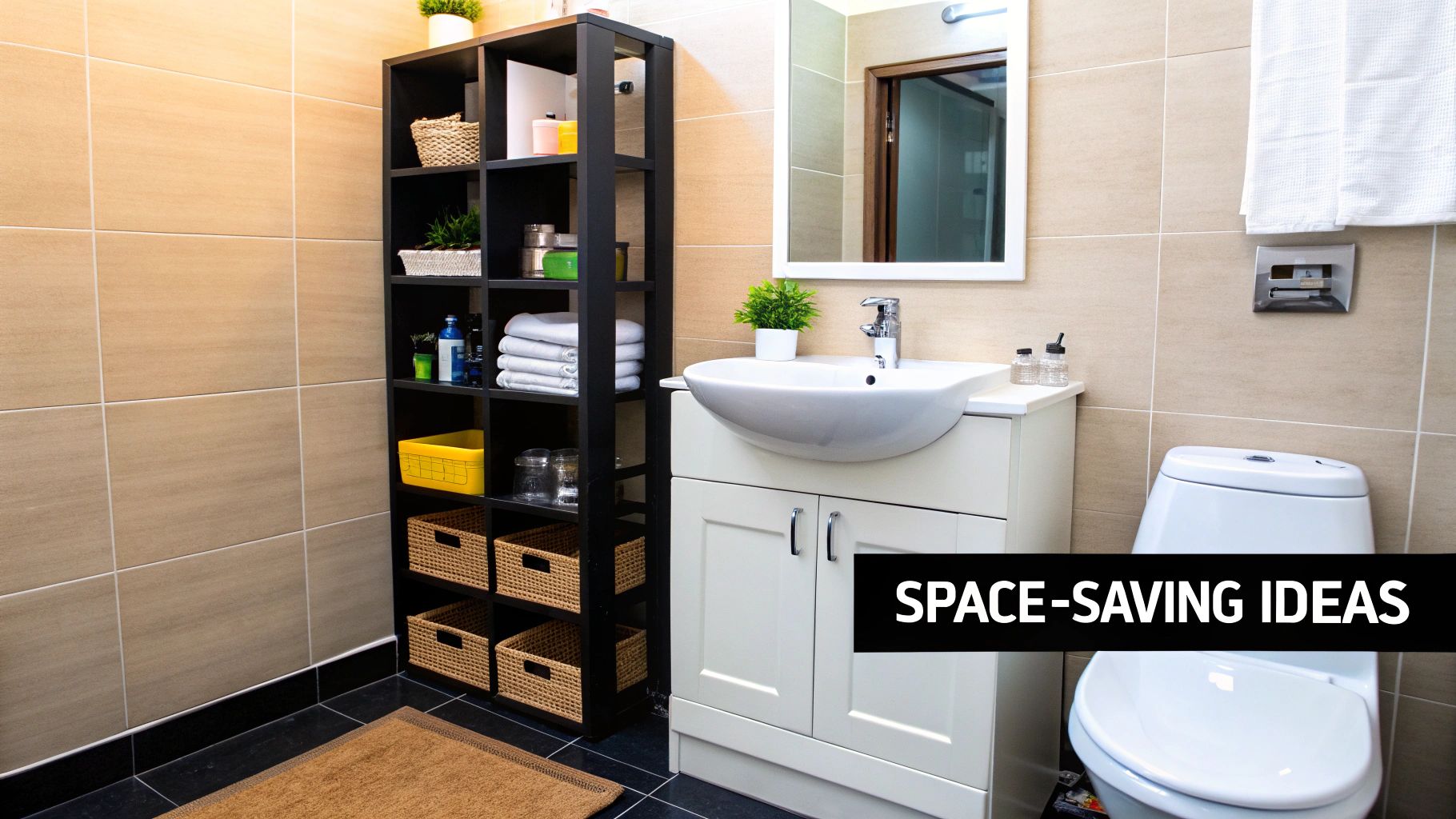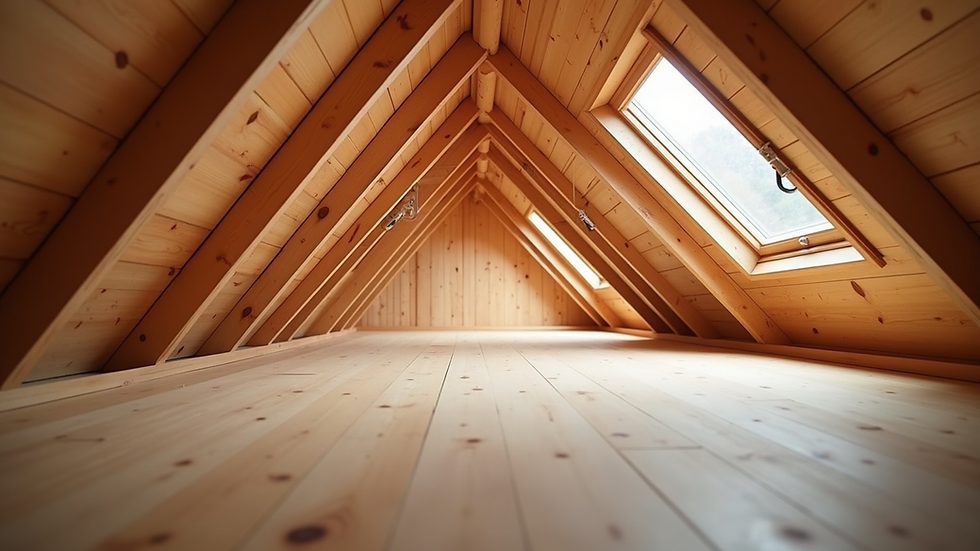Bathroom Remodel Cost: Complete Guide Of Cost To Remodel A Small Bathroom installer Near Me
- Dan Hall
- Aug 1
- 14 min read
Taking on a renovation can feel a bit overwhelming, but getting a clear picture of the numbers from the get-go makes all the difference. For a basic refresh, the average cost to remodel a small bathroom in the UK usually lands somewhere between £1,700 and £4,600. This price point is really for cosmetic updates, not a full-scale, rip-it-all-out project.
Your Quick Guide to Small Bathroom installations.

Planning a new look for a compact space, like an en-suite or a cloakroom, doesn't have to be a financial puzzle. The final bill for your small bathroom remodel really comes down to a balancing act between the look you're dreaming of and what your budget can handle. Think of it like this: a simple cosmetic spruce-up is worlds away, financially, from a massive overhaul that involves moving pipework or knocking down walls.
The real key to understanding the cost to remodel a small bathroom is knowing where your money is going to go. For the most part, the cost is split three ways: materials, fixtures, and labour. Even what seem like minor choices in these areas can have a surprisingly big impact on the overall cost.
H3: Understanding the Basic Costs
For anyone looking for a style refresh without breaking the bank, the focus tends to be on high-impact, low-cost changes. Going by recent UK estimates, a basic bathroom update is perfectly manageable. A typical budget would cover replacing essentials like the toilet and sink (£500–£1,500), putting in new flooring (£200–£500), and giving the walls a fresh coat of paint (£100–£300).
Labour for these straightforward jobs usually comes in between £500 and £1,500. It's always a good idea to set aside a contingency fund of around £300 to £500 just in case any surprises pop up along the way. For a more granular look at these figures, you can explore the full cost analysis from Royal Bathrooms.
The Takeaway: The total spend is directly tied to the scale of your ambition. A simple refresh can be done on a modest budget, but costs will naturally climb with every extra feature or change you decide to make.
To help you visualise this better, let's break down the typical costs for individual items in a budget-friendly small bathroom update.
Estimated Cost Breakdown for a Basic Small Bathroom Refresh
Here’s a table showing what you might expect to pay for each component in the UK.
Component | Estimated Cost Range (UK) |
|---|---|
Toilet | £150 – £400 |
Basin & Taps | £100 – £350 |
Shower or Bath | £250 – £600 |
Tiling (Materials) | £20 – £50 per sq. metre |
Flooring (Vinyl/LVT) | £15 – £40 per sq. metre |
Basic Labour | £500 – £1,500 |
As you can see, the overall cost to remodel a small bathroom can be kept in check by making smart, budget-conscious choices for each element. By focusing on the essentials, you can achieve a fresh, modern look without letting the budget spiral.
Breaking Down the Costs of a Full Remodel
While a cosmetic refresh is a fantastic way to get a quick and affordable update, a full remodel is a different beast altogether. This is where you take the room right back to its bare bones—the studs and the subfloor—and essentially build a brand-new bathroom from the ground up. It’s an approach that gives you a completely blank canvas, but it also demands a more significant investment of both time and money.
When we talk about the cost to remodel a small bathroom, a full-gut renovation means looking far beyond just the shiny new taps and tiles you can see. The total price tag includes all the crucial ‘unseen’ work: plumbing, electrical wiring, waterproofing, and prepping every surface for its new finish. Getting these foundational steps right is what ensures your new bathroom will be safe, functional, and built to last.
Core Costs of a Gut Renovation
Starting from scratch means that every single item, from the smallest screw to the main fixtures, adds to the final bill. The main expenses fall into three buckets: materials, fixtures, and labour. Within each of these, you’ll find different tiers of quality that can dramatically affect the price.
In the UK, a basic full remodel for a compact space—think a cloakroom or a small en-suite—typically lands somewhere between £2,000 and £4,500. This budget generally gets you entry-level materials and assumes you won’t be moving the plumbing around too much.
For example, you could source a set of budget-friendly fixtures like a close-coupled toilet, a pedestal basin, and a standard acrylic bath for around £400 to £800. Simple ceramic tiles might run you £10 to £20 per square metre, while the essential plumbing work could add £600 to £1,200 to the total.
A full remodel is like having a suit custom-tailored instead of buying one off the rack. Every single choice, from the thread (your plumbing) to the fabric (your tiles), is selected and fitted perfectly to your space, and that bespoke quality is reflected in the final cost.
Breaking Down Labour and Material Expenses
In a full remodel, skilled labour is often the single biggest line item on your invoice. Unlike a straightforward fixture swap, a gut renovation calls for a whole team of tradespeople.
Plumbing and Electrical: Set aside a healthy portion of your budget for this. Basic electrical updates for new lighting or an extractor fan can add £300 to £500. If you’re getting into more complex work like moving soil pipes or adding new electrical circuits, that figure will climb.
Tiling and Installation: This cost is a double-whammy: you're paying for the tiles themselves and for the expert labour to fit them. Intricate patterns or large-format tiles demand more skill and time, which naturally pushes up the installation cost.
Labour Rates: Outside of London, you can expect daily rates for good tradespeople to be in the £180 to £250 range. A full small bathroom remodel can take anywhere from 5 to 10 working days, depending on how complex the job is.
For a comprehensive project that needs multiple trades, bringing in a full-service renovation team can make the whole process much smoother. To see how we manage these kinds of projects, feel free to check out our professional services for bathroom and kitchen renovations. An all-in-one approach ensures every element, from the pipework to the plastering, is handled seamlessly.
Key Factors That Drive Your Remodel Price

The cost to remodel a small bathroom isn’t a single, fixed number. It’s a flexible figure shaped by several key decisions you'll make along the way. Think of your budget as a set of scales; every choice, from the tiles on the wall to the taps on the basin, tips the balance towards a higher or lower final spend.
The two biggest things that will move the needle on your total cost are always the project scope and the quality of the materials you choose. A simple cosmetic update—like a fresh coat of paint and new fixtures in the same spot—will always be much lighter on the wallet than a full-scale renovation that involves tearing down walls or moving pipes.
Scope and Complexity of Work
The scope of your project is hands down the most important factor influencing the final bill. Are you thinking of a straightforward cosmetic refresh, or a complete overhaul that involves moving plumbing around?
For instance, swapping an old toilet for a new one is a relatively small job. But if you decide you want that toilet on the other side of the room, you’ve just introduced a massive layer of complexity. This means rerouting waste pipes, which is a labour-intensive and costly task for any plumber.
Key Takeaway: The more you alter the existing layout, the higher your labour costs will be. Keeping your toilet, sink, and shower in their current positions is the single most effective way to keep your budget under control.
This is especially true when it comes to plumbing and electrics. Any changes to existing pipework or wiring require certified professionals, which adds a significant chunk to your expenses. If your project involves moving a soil pipe or installing new circuits, it's wise to get an expert opinion first. Exploring professional plumbing services can give you a much clearer idea of what that kind of work actually entails.
Material and Fixture Quality
After labour, the quality of materials and fixtures you pick has the next biggest impact on your budget. The price gap between budget-friendly and luxury options can easily stretch into thousands of pounds.
Think about the choices for each part of the room:
Tiles: Basic ceramic tiles are a solid, cost-effective option, often starting at around £20 per square metre. On the other hand, high-end natural stone or designer porcelain tiles can easily soar past £100 per square metre.
Fixtures: You can pick up a standard toilet and basin set from a high-street retailer for a few hundred pounds. A sleek, wall-hung toilet with a concealed cistern and a designer vanity unit, however, could run into the thousands.
Flooring: Budget-friendly vinyl is a practical and affordable choice for a small bathroom. But if you want a more premium look, Luxury Vinyl Tile (LVT) or waterproof engineered wood will deliver it, but at a much higher price.
Even the stuff you don’t see, like high-quality waterproofing membranes or levelling a subfloor, adds to the final price. While these elements aren't visible, they’re absolutely crucial for a durable, long-lasting renovation. Making smart choices about where to save and where to spend is the key to managing the cost to remodel a small bathroom effectively.
How Your Location Affects Renovation Costs
When you’re pricing up a small bathroom remodel, one of the biggest swing factors is, believe it or not, your postcode. The cost of labour and even some materials can shift quite dramatically depending on where you are in the UK. It’s a classic case of supply and demand, with tradespeople in busy urban centres often charging a premium for their time.
Think of it like this: hiring a plumber in central London is a bit like booking a taxi during rush hour. You're paying extra because the cost of doing business there is simply higher. This geographical price difference means the cost to remodel a small bathroom in the South East will almost always have a steeper final bill than the exact same project in the North of England or Wales.
Understanding Regional Price Variations
This price gap isn’t just about what your plumber or tiler charges per hour. Local supplier costs, transport, and even waste disposal fees can all be higher in more populated areas, and those little extras soon add up. This is why getting quotes from local firms is absolutely essential for building a realistic budget.
Recent data from across the UK really shines a light on these differences. The average ensuite bathroom remodel can swing from around £6,296 at the lower end right up to £9,644, with the national average landing at about £8,104. In the South East, that average nudges up to over £7,800, whereas a similar job in Wales might average closer to £7,300. For a smaller, simpler WC, the UK average is around £3,383. You can find a more detailed breakdown of these renovation costs to see how your own region stacks up.
This handy chart gives you a quick look at the typical costs and timeline you can expect for a small bathroom project.

As you can see, there’s a massive difference in cost between tackling it yourself and bringing in the professionals.
Comparing Costs for Ensuite and WC Renovations
The type of small bathroom you're redoing also matters, especially when you look at it through a regional lens. It makes sense that remodelling an ensuite—with its shower or bath—will cost more than just giving a downstairs loo a facelift.
Key Insight: While the fixtures for an ensuite are pricier, the percentage increase you pay for labour based on your location tends to stay pretty consistent. Whether it’s a big job or a small one, that regional premium will still apply.
To help you put together a realistic budget, I’ve put together a table showing how costs can vary. This gives you a ballpark idea for a small bathroom renovation in different parts of the country.
Average Small Bathroom Renovation Costs by UK Region
Region | Average Cost for a Small Bathroom Remodel |
|---|---|
London & South East | £7,800 - £9,500+ |
South West | £7,000 - £8,500 |
Midlands | £6,800 - £8,200 |
North of England | £6,500 - £7,800 |
Wales | £6,300 - £7,500 |
Scotland | £6,600 - £8,000 |
Northern Ireland | £6,200 - £7,400 |
As the numbers show, where you live sets the baseline. To break it down even further, keep these points in mind:
London and the Home Counties: Brace yourself. Labour and material costs here are at the top end of the scale, often 15-25% higher than in other regions.
Major Northern Cities: Places like Manchester or Leeds will have higher costs than the surrounding countryside but will usually be more affordable than the South East.
Wales and Rural Areas: Generally, these locations have the most competitive labour rates, which can bring the overall cost to remodel a small bathroom down significantly.
At the end of the day, your location is the starting block for your budget. If you understand these regional trends, you can plan your finances much more accurately and avoid any nasty surprises when the quotes start landing on your doormat.
Smart Ways to Save on Your Bathroom Remodel

A stunning bathroom transformation doesn't have to come with a shocking price tag. By making smart, strategic decisions, you can bring down the overall cost to remodel a small bathroom without sacrificing quality or style. It’s all about focusing your budget where it counts and finding clever ways to save on the rest.
The single biggest money-saver? Work with your existing layout.
Think of your plumbing and electrical wiring as the bathroom's skeleton; moving them is like undertaking major structural work on a house. Rerouting pipes and wires is a complex, expensive job that needs skilled tradespeople, and it will inflate your budget faster than anything else. By keeping your toilet, basin, and shower in their current spots, you dodge this major expense entirely.
High-Impact, Low-Cost Strategies
Beyond the layout, your choice of materials plays a massive role in the final bill. You can absolutely achieve a high-end look with budget-conscious materials. For example, instead of pricey natural stone, consider high-quality porcelain or ceramic tiles that offer a similar aesthetic for a fraction of the cost. Luxury Vinyl Tile (LVT) is another fantastic, cost-effective alternative for flooring, giving you durability and water resistance without the premium price.
You can also roll up your sleeves and tackle some of the work yourself. While big jobs like plumbing and electrics should always be left to certified professionals, there are several tasks a confident DIYer can handle:
Demolition: Carefully tearing out old fixtures, tiles, and cabinets can save you hundreds in labour costs.
Painting: A fresh coat of paint is one of the most affordable ways to completely transform the look and feel of a room.
Minor installations: Fitting accessories like towel rails, mirrors, and toilet roll holders are straightforward jobs you can tick off your list.
Upcycling is your secret weapon for a budget-friendly remodel. A dated wooden vanity can be given a completely new lease on life with a bit of sanding, a fresh coat of paint, and new hardware, saving you the cost of buying a new unit.
Smart Shopping and Professional Help
Being a savvy shopper can also lead to significant savings. Keep an eye out for seasonal sales at major retailers for big-ticket items like baths, toilets, and showers. It's also worth looking at ex-display models, which are often sold at a steep discount but are still in excellent condition.
Finally, when it comes to hiring tradespeople, don’t just accept the first quote you get. Always get at least three detailed quotes from different reputable contractors. This not only helps you find a competitive price but also gives you a much better feel for the market rate for the work you need done.
These budget-friendly approaches are just one way to improve your property’s appeal; for more ideas, you can explore our guide to maximise your home value with budget-friendly renovation tips.
Your Small Bathroom Remodel Questions Answered
When you start thinking about a bathroom renovation, it’s natural for a million questions to bubble up. Getting your head around the common issues, timelines, and—most importantly—the cost to remodel a small bathroom can make the whole thing feel a lot less daunting. Having clear, straight answers helps you plan properly and avoid those classic renovation headaches.
Many homeowners first ask themselves if it's even worth the upheaval. And while any remodel takes a bit of planning, what you get at the end is a space that works better for you and adds real value to your home. The trick is to be prepared.
Being prepared means knowing what's coming, from how long it'll take to where the big costs are hiding. Arming yourself with this knowledge is the best way to make sure your project goes off without a hitch and you end up with the bathroom you were hoping for.
How Long Does a Small Bathroom Remodel Take?
Honestly, the timeline for a small bathroom job completely depends on what you're having done. If you’re just after a cosmetic lift—a lick of paint, a new tap, and swapping out the loo—you could be looking at as little as 2-4 days. It’s a fast and very effective way to freshen up the room with minimal fuss.
But if you're planning a full gut-and-replace job, that’s a different story. Tearing everything out, moving pipes around, and putting in all-new tile is a much bigger undertaking. You should probably set aside 1 to 3 weeks for that kind of project. Keep in mind, this can stretch out if your chosen tradesperson is busy or if you uncover nasty surprises, like hidden water damage, which is a frequent unwelcome discovery in older houses.
Is It Cheaper to Keep the Same Bathroom Layout?
Yes, one hundred percent. This is probably the single biggest money-saving decision you can make. Leaving the toilet, sink, and shower or bath exactly where they are is the surest way to keep a lid on the overall cost to remodel a small bathroom. Your existing pipework is already there and doing its job; moving it is a major expense.
Relocating plumbing fixtures isn't just a matter of adding a bit of pipe. It needs a certified plumber to re-route not just the water supply lines but, more critically, the large waste pipes. It’s a complicated, labour-intensive task that can easily tack on hundreds, if not thousands, of pounds to your bill. If your budget is tight, sticking with the layout you have is your best strategy.
Expert Insight: If you can, always design an access panel for your shower or bath plumbing. If the main "wet wall" backs onto a wardrobe or hallway, putting a panel there means a plumber can get in to fix future leaks without having to smash through your beautiful new tiles.
What Is the Most Expensive Part of a Bathroom Remodel?
While it’s the gleaming new fixtures and stylish tiles that catch your eye, it’s usually the labour that takes the biggest bite out of your budget. For most bathroom renovations here in the UK, labour can eat up anywhere from 40% to 60% of the total cost. That's because a proper remodel needs a whole team of skilled pros: plumbers, electricians, tilers, and plasterers.
After labour costs, here are the other items that will make your wallet wince:
Tiling: This is a double-whammy cost. You pay for the tiles themselves, and then you pay for a professional to lay them. If you've chosen massive tiles or a fiddly mosaic pattern, it takes more skill and time, which pushes the price up.
Fixtures: That walk-in shower with the custom glass screen, a fancy freestanding bath, or a high-end vanity unit can quickly become one of the most expensive things in the room.
Should I Add a Contingency Fund to My Budget?
Absolutely, yes. A contingency fund isn't just a good idea; it's non-negotiable for any renovation. The industry standard is to set aside a safety net of 10% to 20% of your total project estimate. This money is purely for dealing with those "uh-oh" moments that are so common when you start pulling things apart.
Think of it as your project's insurance policy. As soon as you open up walls and pull up floors, you can find all sorts of problems—rotten floorboards, ancient and unsafe wiring, or slow leaks that have been silently causing damage for years. All of these must be fixed before the new stuff can go in. Without that contingency fund, a surprise like this could completely wreck your budget or force you to cut corners on the design you really wanted.
Planning a renovation project can be complex, but you don't have to do it alone. Hallmoore developments offers expert guidance and professional services for everything from plumbing and plastering to full bathroom and kitchen remodels. Let us help you bring your vision to life. Find out more at https://www.hallmoore.co.uk.
.png)



Comments